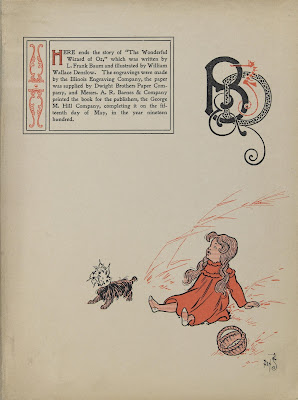














[click to enlarge images - some minor cosmetic blemishes have been removed from all of them]
 William Wallace Denslow (1856-1915) attended art and design schools in New York City and published his first illustrations in 'Hearth and Home' at the age of eighteen. For the next twenty five years he plied his trade all over the country, supplying magazine, newspaper, advertising and book illustrations to a wide variety of publications, and he was a well known poster artist by the mid-1890s.
William Wallace Denslow (1856-1915) attended art and design schools in New York City and published his first illustrations in 'Hearth and Home' at the age of eighteen. For the next twenty five years he plied his trade all over the country, supplying magazine, newspaper, advertising and book illustrations to a wide variety of publications, and he was a well known poster artist by the mid-1890s. For a few years Denslow worked part-time for Elbert Hubbard at the Roycroft Arts Community in East Aurora, New York State, where his humorous social and political cartoons graced the community newspaper, 'The Philistine'. He also provided drawings for the limited edition hand bound Roycroft books for which he trained local women to colour the illustrations. By this stage, Denslow was well known for including a hippocampus (seahorse) as part of his signature and the symbol was variously adapted as seals and watermarks and became synonymous with the Roycroft stable of handcrafted goods.
For a few years Denslow worked part-time for Elbert Hubbard at the Roycroft Arts Community in East Aurora, New York State, where his humorous social and political cartoons graced the community newspaper, 'The Philistine'. He also provided drawings for the limited edition hand bound Roycroft books for which he trained local women to colour the illustrations. By this stage, Denslow was well known for including a hippocampus (seahorse) as part of his signature and the symbol was variously adapted as seals and watermarks and became synonymous with the Roycroft stable of handcrafted goods.In 1898 Denslow supplied a couple of illustrations for inclusion in a privately published book ('By the Candelabra's Glare') by an acquaintance, L.Frank Baum. They collaborated more closely the following year for Baum's 'Father Goose: His Book'. This was Denslow's first foray into childrens book illustrations and both author and illustrator were adamant that the book should be printed in colour which required that they pay for the printing costs themselves. It proved to be the best selling childrens book of the year and no doubt provided the capital, momentum and confidence to repeat the process the following year.
'The Wonderful Wizard of Oz' was an innovative book not least because of the twenty four full colour plates and myriad monochromatic illustrations in which the colour changed according to the location in the story (Kansas = grey, Emerald City = green and so on). With the illustrative vignettes often encroaching on the text area, the type was cleverly printed over the top of the coloured images. Such elaborate printing techniques again required that Baum and Denslow fund the printing costs and the book was published by George M Hill and Company of Chicago and New York in 1900 for $1.50 per copy. It was apparently successful.
 Each of the books in which Baum and Denslow collaborated was held in joint copyright and it was probably inevitable that these two successful and strongly individual types would end up having royalty conflicts. Denslow published magazine and book illustrations featuring characters from the Goose and Oz books without Baum's knowledge. The partnership ultimately ended over a dispute about the division of spoils from the Broadway musical of Oz in 1902. Denslow continued to produce many successful childrens books and with the fortune amassed from this and his previous work with Baum, he bought an island near Bermuda and installed himself as King, under the hippocampus flag.
Each of the books in which Baum and Denslow collaborated was held in joint copyright and it was probably inevitable that these two successful and strongly individual types would end up having royalty conflicts. Denslow published magazine and book illustrations featuring characters from the Goose and Oz books without Baum's knowledge. The partnership ultimately ended over a dispute about the division of spoils from the Broadway musical of Oz in 1902. Denslow continued to produce many successful childrens books and with the fortune amassed from this and his previous work with Baum, he bought an island near Bermuda and installed himself as King, under the hippocampus flag.- 'The Wonderful Wizard of Oz' is online in its entirety at the Library of Congress [Rare Book and Special Collections Division].
- 'The Wizard of Oz - An American Fairy Tale' exhibition site at the Library of Congress.
- 'The Man Behind the Man Behind Oz: W. W. Denslow at 150' by Michael Patrick Hearn at the American Institute for Graphic Arts (AIGA).
- WW Denslow - The Seahorse Design (Dard Hunter Studios).
- 'Back to Oz' by Cecelia Goodnow (Seattle PI, 2001).
- The webpage of the Roycrofters and The Roycroft Community 1894-1938.
- The International Wizard of Oz Club Resources - I found the chronology particularly interesting.
- In a collectible sense, The Wizard of Oz is an industry unto itself: see Bookride's recent review of first edition pricings and 'Oz Book First Editions: How to Identify', an ebay guide.
Tidak ada komentar:
Posting Komentar